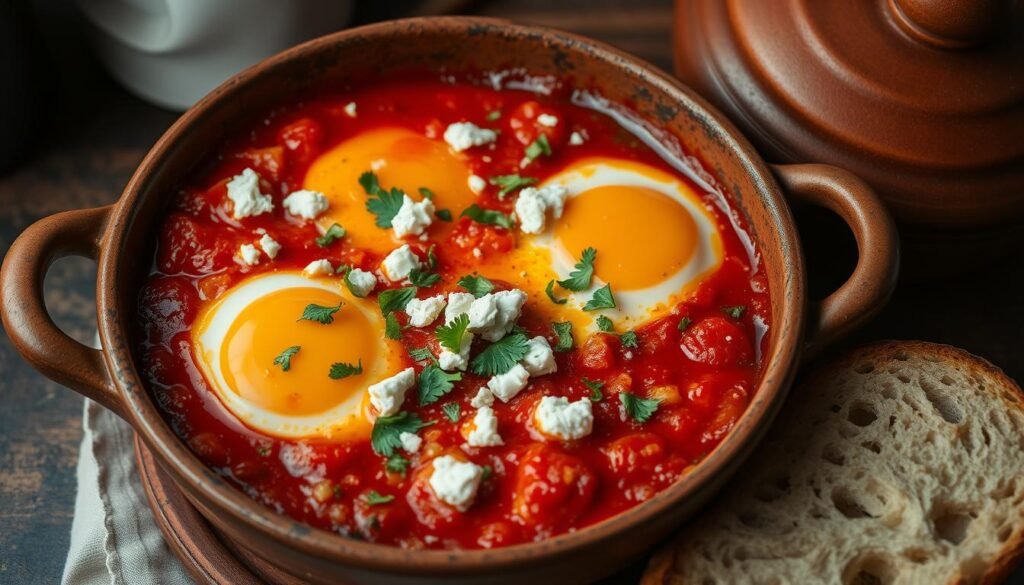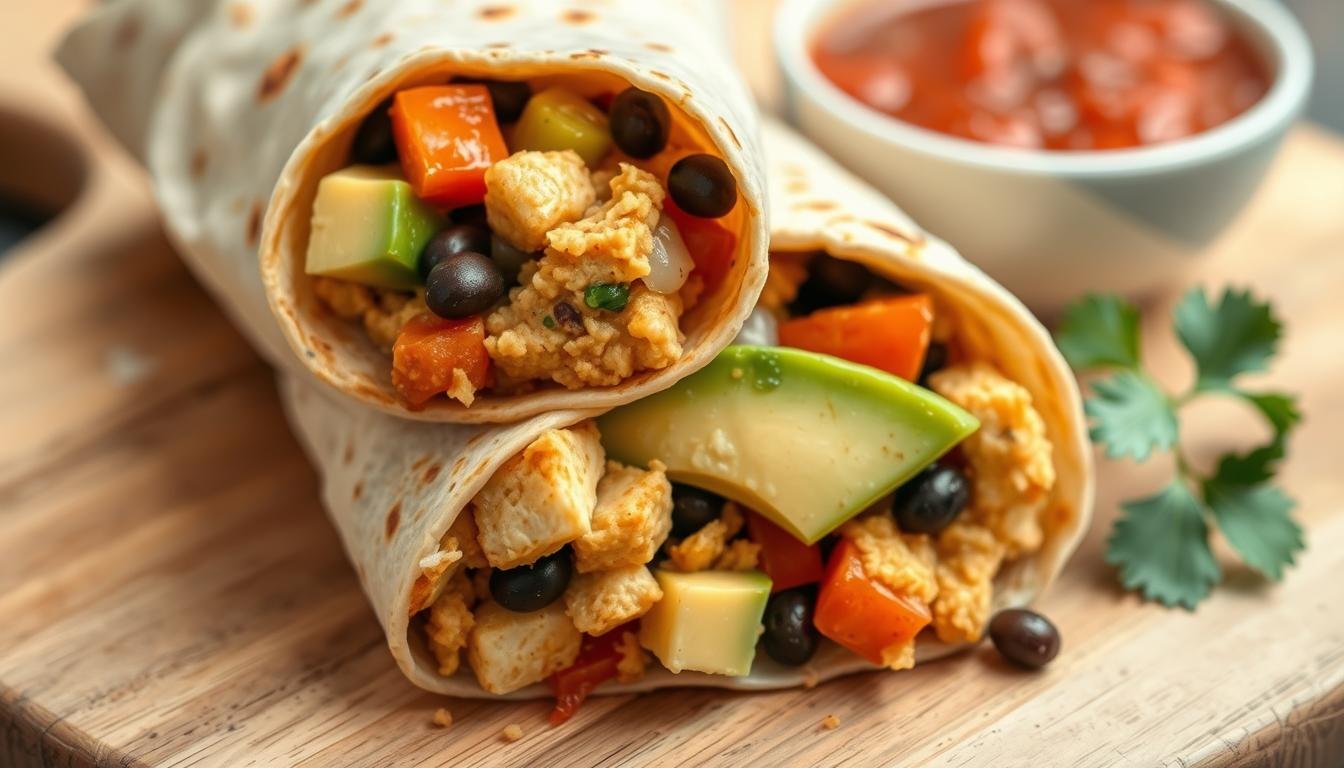Imagine a skillet full of tomatoes, smoky paprika, and silky eggs. It’s topped with creamy feta. This is shakshuka, making breakfast a flavor party. The smell of garlic and cumin makes your kitchen feel like a Mediterranean café.
People are searching for this dish 200% more than before. After trying many versions, I found a way to make it easy and true to tradition.
What makes this dish special? It’s the one-pan simplicity and feta’s salty taste. The feta melts into the tomatoes like a secret. I tried cooking it on the stovetop and in the oven.
The stovetop gives richer flavor, and the oven makes sure the eggs are perfect. Either way, it’s great for any day.
Want to make it your own? Add spinach, use goat cheese, or add chili flakes. This recipe is like an invitation to play with fire. Let’s make your breakfast a masterpiece.
Key Notes;
- Master a one-pan Mediterranean classic in under 30 minutes
- Feta cheese adds authentic creaminess and balances the dish’s acidity
- Choose between stovetop (for depth) or oven baking (for precision)
- Easily customize with veggies, spices, or alternative cheeses
- Perfect for entertaining or solo meals with leftovers that reheat beautifully
Authentic Breakfast Shakshuka Recipe with Feta
Waking up to the smell of tomatoes, spices, and eggs is amazing. My easy shakshuka recipe brings North African warmth in under an hour. It mixes tangy feta with smoky paprika.
Essential Ingredients for Traditional Flavor
Fresh produce is key. I use ripe plum tomatoes for their low moisture. Canned San Marzanos are okay if fresh ones are hard to find. Here’s what you need:
- 1 red bell pepper (thinly sliced)
- 1 yellow onion (diced)
- 4 garlic cloves (minced)
- 2 tsp cumin + 1.5 tsp smoked paprika
- 6 large eggs
- ½ cup crumbled feta
“The cumin-paprika duo is the soul of shakshuka. Toast them briefly to unlock earthy depth.”
| Fresh Tomatoes | Canned Tomatoes | |
|---|---|---|
| Flavor | Bright, acidic | Rich, concentrated |
| Prep Time | 10 min (chopping) | 0 min |
| Best For | Summer batches | Year-round convenience |
Step-by-Step Simmering Technique
- Caramelize onions in olive oil for 15 minutes until golden
- Add peppers and garlic, sauté until softened
- Stir in spices and tomatoes, simmer 20 minutes
- Create 6 wells with a wooden spoon, crack eggs into nests
- Transfer skillet to 375°F oven for 7-9 minutes
Keep an eye on the eggs. They should jiggle a bit. Add feta right after baking. It should soften but not melt. Serve from the skillet for a wow effect.
Customizing Your Shakshuka Experience
This Mediterranean breakfast dish is fun to change up. You can make it mild or spicy, depending on what you like. I’ll show you how to make it your own with what you have at home.
Heat Level Adjustments
It’s easy to change how spicy it is. For a little warmth, add ½ tsp of harissa paste while it simmers. This adds a smoky flavor without being too hot.
If you like it hotter, add 1 tbsp of harissa or ¼ tsp of red pepper flakes in the egg wells.
My secret: “Always taste your sauce before adding eggs”. This helps avoid too much heat. If it’s too spicy, try:
- A drizzle of honey
- Extra crumbled feta
- Cooling yogurt dollops
Vegetable Additions and Swaps
While bell peppers and onions are classic, feel free to try new things. Last week’s roasted veggies can be tomorrow’s shakshuka stars. Here’s a guide to swapping veggies:
| Vegetable | Texture | Cooking Time |
|---|---|---|
| Zucchini | Tender-Crisp | Add last 8 mins |
| Eggplant | Creamy | Pre-roast 15 mins |
| Mushrooms | Meaty | Sear before adding |
For a green twist, add spinach or kale at the end. Their earthy taste goes well with tomatoes. Just make sure to wilt greens before cracking eggs to avoid sogginess.
Cheese Variations Beyond Feta
Feta isn’t the only star in the shakshuka universe. While my vegetarian shakshuka with feta recipe delivers classic Mediterranean flair, experimenting with cheese alternatives can refresh this dish for new tastes or dietary needs. Let’s explore how different options affect texture and flavor balance.
Goat Cheese Alternative
Swap feta for creamy goat cheese to create a richer, tangier profile. Unlike feta’s crumbly texture, goat cheese melts into the tomato base, adding a velvety consistency. For best results, add it after simmering the sauce – this preserves its distinct sharpness without overwhelming other ingredients.
Pair this version with kalamata olives or artichoke hearts to complement the cheese’s earthy notes. I’ve found that soft goat cheese blends seamlessly, while aged varieties offer a bolder tang similar to feta’s signature punch.
Dairy-Free Options
Nutritional yeast or almond-based cheeses work beautifully for plant-based adaptations. Look for products containing calcium citrate – this additive helps vegan cheeses melt smoothly into the sauce. My top pick crumbles like traditional feta but uses fermented almond milk for a convincing salty finish.
For extra creaminess without dairy, try these alternatives:
- Cashew cream stirred in during the final simmer
- Tahini dolloped over individual servings
- Toasted sesame seeds for nutty texture
Remember: Dairy-free cheeses often require shorter cooking times. Add them just before serving to maintain ideal consistency in your shakshuka.
Dietary Adaptations Made Simple
Shakshuka is great for many diets. It works well for vegan, keto, and paleo eating. I’ve tried these changes to keep the taste good and follow the diet rules.
Plant-Powered Breakfast Solution
To make shakshuka vegan, we need to swap eggs. Here are some good choices:
- Crumbled firm tofu (14g protein per ½ cup)
- Chickpea flour batter (6g protein per ¼ cup)
- Lentil-based scramble (9g protein per serving)
| Option | Prep Time | Texture |
|---|---|---|
| Tofu | 5 minutes | Firm, egg-like |
| Chickpea Flour | 10 minutes | Custardy |
| Lentils | 15 minutes | Meaty |
Marinate tofu in turmeric and black salt. It tastes like eggs.
Low-Carb Morning Fuel
For a keto-friendly shakshuka, we cut carbs and add fats. Here’s how:
- Replace tomatoes with roasted red peppers (3g net carbs vs 5g)
- Use spiralized zucchini instead of bread for dipping
- Add avocado oil or ghee for healthy fats
This keto shakshuka has only 7g net carbs. Add almond flour crackers for crunch without carbs.
Ancient Nutrition Approach
Paleo shakshuka removes legumes and dairy. It focuses on whole foods. Here’s what to do:
- Swap feta with crushed macadamia nuts
- Use coconut aminos instead of paprika for depth
- Opt for pasture-raised eggs or wild-caught seafood
This version has 22g protein. It’s my top healthy breakfast recipe for morning energy.
The Cultural Journey of Shakshuka
Shakshuka is a dish with a rich story. It started in North Africa and now is loved around the world. It has become a favorite for breakfast, blending local tastes with its original charm.
North African Origins
Shakshuka comes from the 16th century Ottoman kitchens. Berber people in Tunisia and Libya made it famous. They used tomatoes, peppers, and eggs.
Spice traders spread it along the Mediterranean. Each place added its own twist. It was a simple food for peasants.
The name “shakshouka” means “mixture” in Arabic. It was made with leftover veggies and spices like cumin and paprika.
Global Interpretations
Jewish immigrants brought shakshuka to Israel in the 1950s. It quickly became a favorite breakfast. Tel Aviv cafes serve thousands of shakshuka plates every day.
But it didn’t stop there. Different places made their own versions:
| Region | Distinctive Features | Key Ingredients |
|---|---|---|
| Tunisia | Spicy merguez sausage | Harissa, fennel |
| Yemen | Zhug herb sauce | Cilantro, green chilies |
| Turkey | Menemen variation | Green peppers, kasar cheese |
| USA | Avocado toppings | Goat cheese, kale |
New York chefs made a “Brookshuka” with bagel spices and lox. Shakshuka’s journey shows how food brings people together. It’s loved in Istanbul and Austin, each with its own twist.
Perfect Pairings and Presentations

When you mix textures and flavors around your skillet, magic happens. The right sides make your homemade breakfast shakshuka go from good to great. You get a perfect mix of the tomato sauce and eggs.
Let’s see how bread, fresh herbs, and avocado can make your dish look amazing.
Bread Selection Guide
Choosing the right bread changes how you enjoy your meal. Crusty sourdough holds up well to the sauce. Warm pita is soft and great for scooping.
For outdoor brunches, grilled ciabatta is perfect. Its smoky taste goes well with the spices.
| Bread Type | Texture | Sauce Absorption |
|---|---|---|
| Sourdough | Crispy crust | Medium |
| Pita | Chewy | High |
| Ciabatta | Airy interior | Low |
Fresh Herb Garnishes
Herbs make your dish bright and fresh. Cilantro adds a citrusy taste that goes well with spices. Parsley is milder and adds a grassy flavor.
For the best look:
- Chop herbs just before serving
- Mix microgreens with larger leaves
- Add mint sprigs for a surprise
Avocado Accompaniments
Creamy avocado slices make your homemade breakfast shakshuka healthier. Spread them out or dice them for mixing. For a beachy look, place avocado roses next to eggs.
Remember, cold avocado cools down spicy food. Lime-dressed avocado adds a tangy taste. Add cucumber ribbons for crunch and a fancy touch.
Meal Prep Strategies for Busy Mornings
Mastering breakfast is easy with a easy shakshuka recipe prep. I’ve made it simple to enjoy this Mediterranean dish, even on busy days. You won’t lose any flavor or texture.
Base Sauce Preparation
Make the tomato-pepper sauce up to four days early. Cook it, then cool it down. Put it in airtight containers.
For longer storage, freeze it in ice cube trays:
- Pour cooled sauce into trays (leave ¼ inch space for expansion)
- Freeze solid (about 4 hours)
- Transfer cubes to freezer bags (label with date)
Thaw it in the fridge overnight or use the defrost setting on your microwave. This keeps the sauce’s bright flavor. It’s key for balancing the eggs.
Reheating Techniques
Bring your prepped shakshuka back to life. Keep the eggs runny:
| Method | Time | Best For |
|---|---|---|
| Stovetop | 6-8 minutes | Weekend brunch |
| Microwave | 1-2 minutes | Rush mornings |
For stovetop, warm the sauce on low with a bit of water. Make wells for eggs, cover, and simmer until whites set. Microwave users, heat in 45-second bursts, stirring between. Always crack eggs into warm sauce – not cold.
Essential Cooking Tools

Your skillet choice is key for making great homemade breakfast shakshuka. Different materials can change how the dish tastes and how easy it is to make. Let’s look at the best options for a tasty mix of tomatoes and eggs.
Cast Iron Skillet Benefits
Cast iron is the best for those who love even heat. It keeps the heat steady, which is great for cooking sauce and eggs at the same time. It’s also good for moving from the stovetop to the broiler without bending.
Cast iron keeps heat better than stainless steel, which is good for deep flavors. But, make sure to season it well to stop acidic tomatoes from harming the metal.
Alternative Pan Options
Stainless steel is great for those who need to control the heat. It’s light, making it easy to mix the sauce. But, you have to watch the heat to avoid sticking.
Non-stick pans are good for quick meals. But, don’t use high heat to avoid damaging the coating.
When using other pans:
- Make sure they can go in the oven if you’re finishing under the broiler
- Choose pans with deep sides to hold the sauce
- Use medium heat with non-stick pans
No matter if you like cast iron or stainless steel, the right pan makes your shakshuka taste amazing. Use a strong spatula for easy egg-poaching and serving.
Troubleshooting Common Issues
Even the tastiest breakfasts can have problems. Let’s fix two common shakshuka issues. We’ll keep the flavor and texture just right.
Preventing Egg Overcooking
Perfect eggs are key to shakshuka. Timing is everything. I cook eggs 6-8 minutes for runny yolks or 10-12 minutes for firm.
Here’s how I do it:
- Create deep wells in sauce before cracking eggs
- Cover pan immediately after adding eggs
- Remove from heat when whites just set
Heat from the pan keeps cooking eggs. For a guide:
| Doneness | Cook Time | Yolk Texture |
|---|---|---|
| Soft | 6-8 min | Runny |
| Medium | 9-10 min | Custardy |
| Hard | 11-12 min | Fully set |
Sauce Consistency Fixes
Tomato sauce too watery or thick? Both are fixable without losing flavor. For thin sauces:
- Mix 1 tsp cornstarch with 1 tbsp cold water
- Stir slurry into simmering sauce
- Cook 2 minutes until glossy
For thick sauces, add broth or water 1 tbsp at a time. My secret?
“Better to under-reduce – you can always cook longer, but you can’t undo burnt tomatoes.”
Nutritional Breakdown

This shakshuka is more than just tasty. It’s a nutrient-dense meal that starts your day right. Let’s look at why it’s so good for you.
Macronutrient Profile
Each serving has 163 calories. It’s a mix of proteins, fats, and carbs. The eggs and feta give you complete protein, with all nine essential amino acids. You’ll get:
- 12g protein for muscle support
- 11g healthy fats (mostly from olive oil and cheese)
- 9g complex carbs from tomatoes and peppers
Vitamin and Mineral Highlights
Cooked tomatoes have lycopene, good for your heart. The dish also gives you:
- 45% daily vitamin C from bell peppers
- 20% vitamin A needs from tomato carotenoids
- 15% calcium RDI through feta cheese
Egg yolks have choline for your brain. Paprika adds iron. So, our shakshuka is a smart choice for a healthy breakfast.
Conclusion
This shakshuka recipe is a top pick for breakfast. It’s great for everyone because you can make it your way. You can add spice or keep it mild, and even make it vegan.
Try serving it in a cast iron skillet. It’s perfect for family meals. Everyone can enjoy the sauce with sourdough bread.
Want a pretty dish for Instagram? Use red, yellow, and orange peppers. Add avocado and fresh dill for extra flavor.
Make this recipe your own. Try new veggies, cheeses, or even cauliflower rice. Share your dish with #ShakshukaVibes. I’m excited to see your creations.
Your next breakfast adventure is just a skillet away. Get creative and enjoy!









